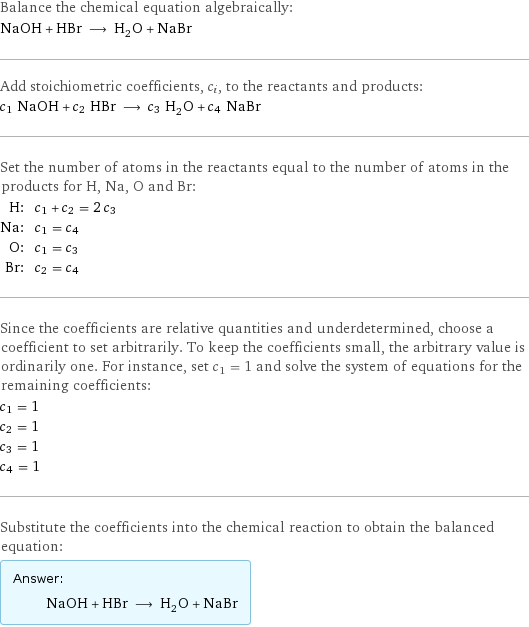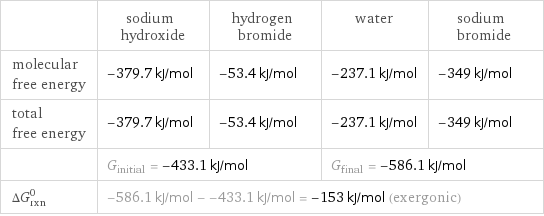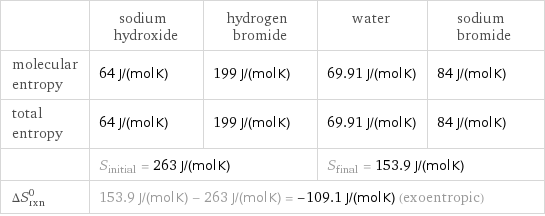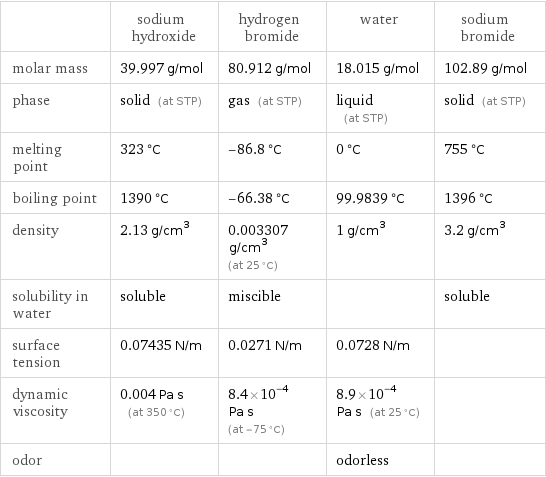Input interpretation

NaOH sodium hydroxide + HBr hydrogen bromide ⟶ H_2O water + NaBr sodium bromide
Balanced equation

Balance the chemical equation algebraically: NaOH + HBr ⟶ H_2O + NaBr Add stoichiometric coefficients, c_i, to the reactants and products: c_1 NaOH + c_2 HBr ⟶ c_3 H_2O + c_4 NaBr Set the number of atoms in the reactants equal to the number of atoms in the products for H, Na, O and Br: H: | c_1 + c_2 = 2 c_3 Na: | c_1 = c_4 O: | c_1 = c_3 Br: | c_2 = c_4 Since the coefficients are relative quantities and underdetermined, choose a coefficient to set arbitrarily. To keep the coefficients small, the arbitrary value is ordinarily one. For instance, set c_1 = 1 and solve the system of equations for the remaining coefficients: c_1 = 1 c_2 = 1 c_3 = 1 c_4 = 1 Substitute the coefficients into the chemical reaction to obtain the balanced equation: Answer: | | NaOH + HBr ⟶ H_2O + NaBr
Structures

+ ⟶ +
Names

sodium hydroxide + hydrogen bromide ⟶ water + sodium bromide
Reaction thermodynamics
Enthalpy

| sodium hydroxide | hydrogen bromide | water | sodium bromide molecular enthalpy | -425.8 kJ/mol | -36.3 kJ/mol | -285.8 kJ/mol | -361.1 kJ/mol total enthalpy | -425.8 kJ/mol | -36.3 kJ/mol | -285.8 kJ/mol | -361.1 kJ/mol | H_initial = -462.1 kJ/mol | | H_final = -646.9 kJ/mol | ΔH_rxn^0 | -646.9 kJ/mol - -462.1 kJ/mol = -184.8 kJ/mol (exothermic) | | |
Gibbs free energy

| sodium hydroxide | hydrogen bromide | water | sodium bromide molecular free energy | -379.7 kJ/mol | -53.4 kJ/mol | -237.1 kJ/mol | -349 kJ/mol total free energy | -379.7 kJ/mol | -53.4 kJ/mol | -237.1 kJ/mol | -349 kJ/mol | G_initial = -433.1 kJ/mol | | G_final = -586.1 kJ/mol | ΔG_rxn^0 | -586.1 kJ/mol - -433.1 kJ/mol = -153 kJ/mol (exergonic) | | |
Entropy

| sodium hydroxide | hydrogen bromide | water | sodium bromide molecular entropy | 64 J/(mol K) | 199 J/(mol K) | 69.91 J/(mol K) | 84 J/(mol K) total entropy | 64 J/(mol K) | 199 J/(mol K) | 69.91 J/(mol K) | 84 J/(mol K) | S_initial = 263 J/(mol K) | | S_final = 153.9 J/(mol K) | ΔS_rxn^0 | 153.9 J/(mol K) - 263 J/(mol K) = -109.1 J/(mol K) (exoentropic) | | |
Equilibrium constant
![Construct the equilibrium constant, K, expression for: NaOH + HBr ⟶ H_2O + NaBr Plan: • Balance the chemical equation. • Determine the stoichiometric numbers. • Assemble the activity expression for each chemical species. • Use the activity expressions to build the equilibrium constant expression. Write the balanced chemical equation: NaOH + HBr ⟶ H_2O + NaBr Assign stoichiometric numbers, ν_i, using the stoichiometric coefficients, c_i, from the balanced chemical equation in the following manner: ν_i = -c_i for reactants and ν_i = c_i for products: chemical species | c_i | ν_i NaOH | 1 | -1 HBr | 1 | -1 H_2O | 1 | 1 NaBr | 1 | 1 Assemble the activity expressions accounting for the state of matter and ν_i: chemical species | c_i | ν_i | activity expression NaOH | 1 | -1 | ([NaOH])^(-1) HBr | 1 | -1 | ([HBr])^(-1) H_2O | 1 | 1 | [H2O] NaBr | 1 | 1 | [NaBr] The equilibrium constant symbol in the concentration basis is: K_c Mulitply the activity expressions to arrive at the K_c expression: Answer: | | K_c = ([NaOH])^(-1) ([HBr])^(-1) [H2O] [NaBr] = ([H2O] [NaBr])/([NaOH] [HBr])](../image_source/d39b5351136701555e49690938dabb27.png)
Construct the equilibrium constant, K, expression for: NaOH + HBr ⟶ H_2O + NaBr Plan: • Balance the chemical equation. • Determine the stoichiometric numbers. • Assemble the activity expression for each chemical species. • Use the activity expressions to build the equilibrium constant expression. Write the balanced chemical equation: NaOH + HBr ⟶ H_2O + NaBr Assign stoichiometric numbers, ν_i, using the stoichiometric coefficients, c_i, from the balanced chemical equation in the following manner: ν_i = -c_i for reactants and ν_i = c_i for products: chemical species | c_i | ν_i NaOH | 1 | -1 HBr | 1 | -1 H_2O | 1 | 1 NaBr | 1 | 1 Assemble the activity expressions accounting for the state of matter and ν_i: chemical species | c_i | ν_i | activity expression NaOH | 1 | -1 | ([NaOH])^(-1) HBr | 1 | -1 | ([HBr])^(-1) H_2O | 1 | 1 | [H2O] NaBr | 1 | 1 | [NaBr] The equilibrium constant symbol in the concentration basis is: K_c Mulitply the activity expressions to arrive at the K_c expression: Answer: | | K_c = ([NaOH])^(-1) ([HBr])^(-1) [H2O] [NaBr] = ([H2O] [NaBr])/([NaOH] [HBr])
Rate of reaction
![Construct the rate of reaction expression for: NaOH + HBr ⟶ H_2O + NaBr Plan: • Balance the chemical equation. • Determine the stoichiometric numbers. • Assemble the rate term for each chemical species. • Write the rate of reaction expression. Write the balanced chemical equation: NaOH + HBr ⟶ H_2O + NaBr Assign stoichiometric numbers, ν_i, using the stoichiometric coefficients, c_i, from the balanced chemical equation in the following manner: ν_i = -c_i for reactants and ν_i = c_i for products: chemical species | c_i | ν_i NaOH | 1 | -1 HBr | 1 | -1 H_2O | 1 | 1 NaBr | 1 | 1 The rate term for each chemical species, B_i, is 1/ν_i(Δ[B_i])/(Δt) where [B_i] is the amount concentration and t is time: chemical species | c_i | ν_i | rate term NaOH | 1 | -1 | -(Δ[NaOH])/(Δt) HBr | 1 | -1 | -(Δ[HBr])/(Δt) H_2O | 1 | 1 | (Δ[H2O])/(Δt) NaBr | 1 | 1 | (Δ[NaBr])/(Δt) (for infinitesimal rate of change, replace Δ with d) Set the rate terms equal to each other to arrive at the rate expression: Answer: | | rate = -(Δ[NaOH])/(Δt) = -(Δ[HBr])/(Δt) = (Δ[H2O])/(Δt) = (Δ[NaBr])/(Δt) (assuming constant volume and no accumulation of intermediates or side products)](../image_source/c9898dd275e70c511f242ee684ac30ea.png)
Construct the rate of reaction expression for: NaOH + HBr ⟶ H_2O + NaBr Plan: • Balance the chemical equation. • Determine the stoichiometric numbers. • Assemble the rate term for each chemical species. • Write the rate of reaction expression. Write the balanced chemical equation: NaOH + HBr ⟶ H_2O + NaBr Assign stoichiometric numbers, ν_i, using the stoichiometric coefficients, c_i, from the balanced chemical equation in the following manner: ν_i = -c_i for reactants and ν_i = c_i for products: chemical species | c_i | ν_i NaOH | 1 | -1 HBr | 1 | -1 H_2O | 1 | 1 NaBr | 1 | 1 The rate term for each chemical species, B_i, is 1/ν_i(Δ[B_i])/(Δt) where [B_i] is the amount concentration and t is time: chemical species | c_i | ν_i | rate term NaOH | 1 | -1 | -(Δ[NaOH])/(Δt) HBr | 1 | -1 | -(Δ[HBr])/(Δt) H_2O | 1 | 1 | (Δ[H2O])/(Δt) NaBr | 1 | 1 | (Δ[NaBr])/(Δt) (for infinitesimal rate of change, replace Δ with d) Set the rate terms equal to each other to arrive at the rate expression: Answer: | | rate = -(Δ[NaOH])/(Δt) = -(Δ[HBr])/(Δt) = (Δ[H2O])/(Δt) = (Δ[NaBr])/(Δt) (assuming constant volume and no accumulation of intermediates or side products)
Chemical names and formulas

| sodium hydroxide | hydrogen bromide | water | sodium bromide formula | NaOH | HBr | H_2O | NaBr Hill formula | HNaO | BrH | H_2O | BrNa name | sodium hydroxide | hydrogen bromide | water | sodium bromide
Substance properties

| sodium hydroxide | hydrogen bromide | water | sodium bromide molar mass | 39.997 g/mol | 80.912 g/mol | 18.015 g/mol | 102.89 g/mol phase | solid (at STP) | gas (at STP) | liquid (at STP) | solid (at STP) melting point | 323 °C | -86.8 °C | 0 °C | 755 °C boiling point | 1390 °C | -66.38 °C | 99.9839 °C | 1396 °C density | 2.13 g/cm^3 | 0.003307 g/cm^3 (at 25 °C) | 1 g/cm^3 | 3.2 g/cm^3 solubility in water | soluble | miscible | | soluble surface tension | 0.07435 N/m | 0.0271 N/m | 0.0728 N/m | dynamic viscosity | 0.004 Pa s (at 350 °C) | 8.4×10^-4 Pa s (at -75 °C) | 8.9×10^-4 Pa s (at 25 °C) | odor | | | odorless |
Units
